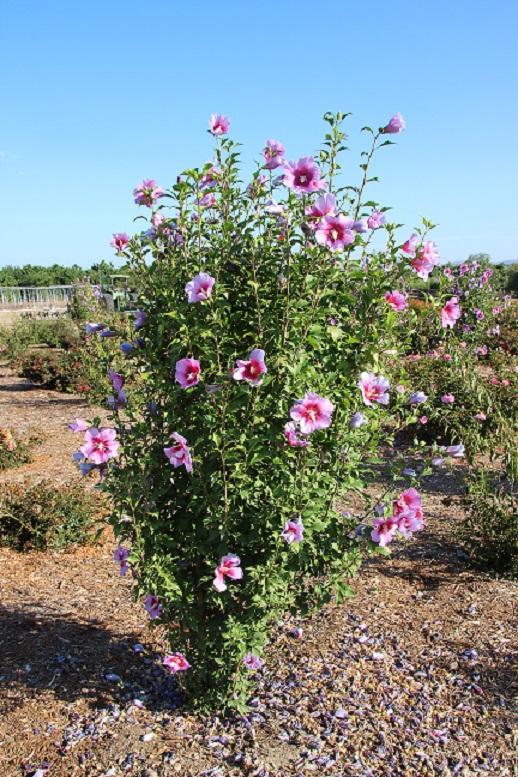Hibiscus syriacus 'Gandini Santiago'
Hibiscus syriacus 'Gandini Santiago' Purple Pillar® on low water in September 2022 at UC Davis. Photo: SK Reid.
Summary
South Coast Research & Extension Center (South Coast REC/SCREC) is located in Irvine California, this site has a sandy loam soil and plants are irrigated with reclaimed water. UC Davis is located in Davis, California, this site has a silty clay loam soil and plants are irrigated with potable water. More information about the field sites is located in the Nuts & Bolts section.
Purple Pillar is a fastigiate (columnar) form of rose of Sharon, reportedly growing to 10-16’ high and 4-5’ wide. The plant is covered with bright green, ovate leaves, with serrated margins, and acute leaf tips, almost resembling arrowheads. Beginning in mid-summer, lavender purple flowers with prominent white stamens and a fuchsia “eye” in the center of the bloom appeared, continuing for the remainder of the season, and providing welcome pops of color in the fall as other plants were ramping down. Purple Pillar is deciduous, losing its leaves in early to mid-winter and pushing out new growth in spring. Purple Pillar was evaluated at UC Davis and South Coast REC (SCREC) with site specific performance details and recommendations below.
UC Davis Trial – Davis, CA
Early in the deficit season as plants were pushing out new growth, there were several nights with temperatures hovering briefly around 38°F (2℃), damaging any growth and resulting in wilted, desiccated leaves. Consequently, additional new growth was delayed. In mid-April to early May some of the foliage appeared chlorotic, with a white to pale chartreuse color on the leaf margins and/or along veins, but as temperatures warmed the foliage took on a deeper green color and this issue disappeared as the season progressed. The tall, narrow form was uniformly maintained across treatments without pruning during the two seasons in the field. Based on the data collected, we observed no differences in overall appearance between the treatments and would assign a Purple Pillar to the Low Category of Water Needs in WUCOLS Region 2.
South Coast REC Trial – Irvine, CA
At South Coast REC, plants grew roughly twice as tall and wide as those at UC Davis. Purple Pillar reached its zenith in July with plants being in full bloom. Over the course of the trial, the branch tips became heavy and prone to leaning over. This cultivar was popular with fauna – attracting insects such as ladybugs and butterflies, with several plants hosting birds’ nests in late spring. As the season progressed leaves turned a darker green, and localized defoliation occurred at the branch apexes. Based on the data collected, we observed no differences in overall appearance between the treatments and would assign Purple Pillar a WUCOLS Low Category of Water Need in Region 3.
Basic Info
| Submitted by: | Spring Meadow Nursery |
| Site(s): | UC Davis & SCREC |
| Trial Exposure: | Sun |
| Year evaluated: | 2022 |
Height & Width after 2 years: | 4-4.6' x 1.9-2.4' - UC Davis 7-7.9’ x 4.3-4.8’ - SCREC |
Reported Height & Width at maturity: | 10-16' x 4-5' |
| WUCOLS plant type: | S |
| Water Needs & WUCOLS Region: | Low - Region 2 Low - Region 3 |
Mean Overall Appearance rating: (1-5 Scale, 5 is highest) | 3.5 - UC Davis 3.8 - SCREC |
| Flowering Months: | July-Oct. - UC Davis April-Oct. - SCREC |
Growth and Quality Data
Click Here for Complete Data Set -UCD
Click Here for Complete Data Set -SCREC

Hibiscus syriacus Purple Pillar® on low water in June and November 2022. Photos: SK Reid and JA Sisneroz.

Hibiscus syriacus Purple Pillar® on low water in August 2022.